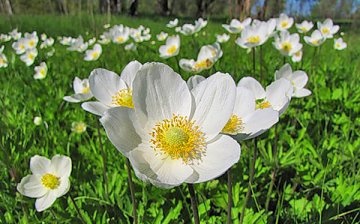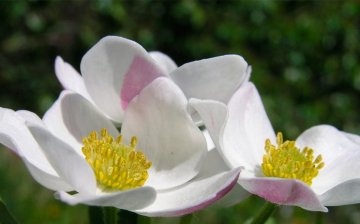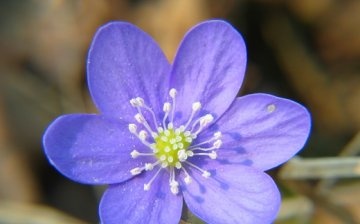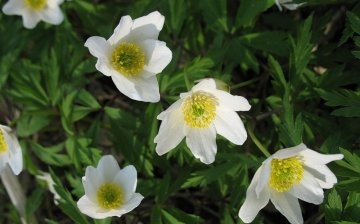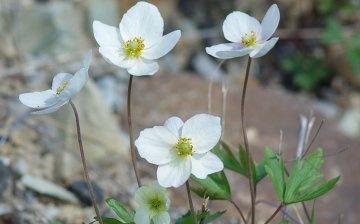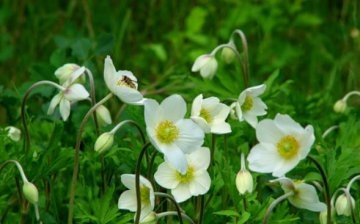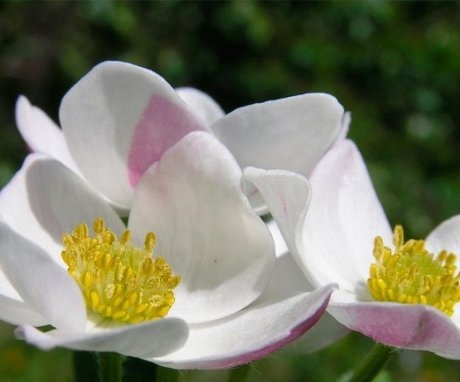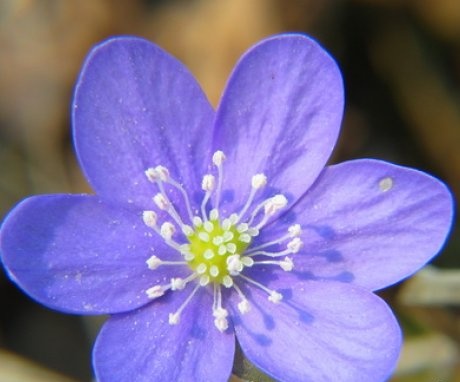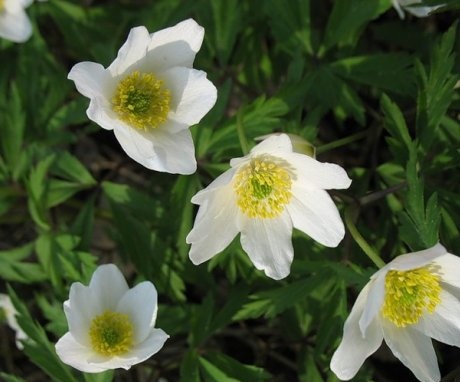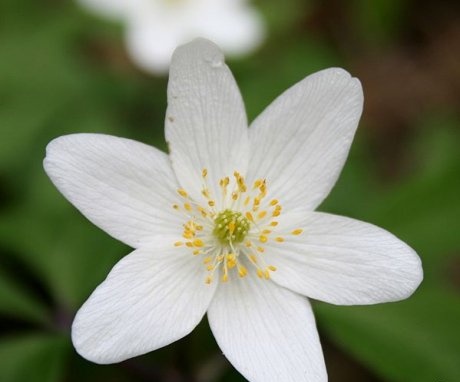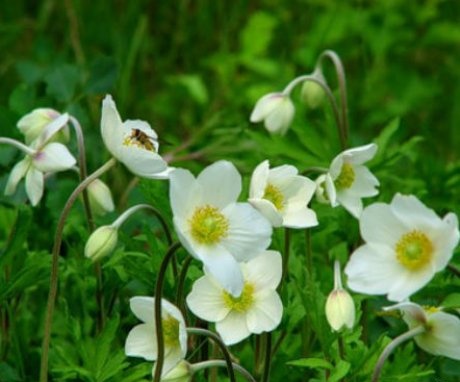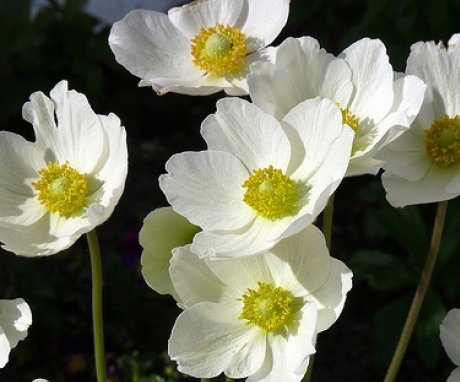Forest anemone - delicate primrose in the garden
With the first warm spring sun, plants begin to wake up. And after a while, the grasses rise and the first flowers bloom, such as snowdrops and scaffolds... With the arrival of constant heat, all forests are covered with white delicate flowers - this is the forest anemone, or anemones. The snow-white bloom resembles spring snow on a hot day. A large number of varieties with a variety of bright colors are grown in culture.
Content:
- General information about the plant
- Popular varieties of anemones
- Perennial care
- Reproduction methods
- Landing
- Application
General information about the plant
Anemone or anemones Is a perennial herb that belongs to the buttercup family. These flowers are common in the temperate climate of Eurasia and America, where they grow naturally in deciduous forests and glades. The height of the plant can reach 90-100 cm, but mostly these are medium-sized representatives.
The buds are located on high peduncles.
The leaves are feathery, thin, outwardly reminiscent of carrot tops. Flowers can be simple, consisting of 5 petals, double and semi-double.
Popular varieties of anemones
Not all anemones are spring flowers. Some varieties bloom in the middle of summer, there are also autumn representatives. With the right combination of anemone species, you can organize a flower bed that will bloom colorfully for almost the entire season.
Varieties:
- Udi anemone. A perennial herb, the height of which does not exceed 20 cm. It has a strong creeping rhizome, grows well, and is often used as a ground cover plant. The leaves are bright green in color, outwardly reminiscent of parsley. Peduncles are thin, medium in size, buds are arranged one at a time. Small flowers up to 4 cm in diameter, blooming period lasts 3 weeks, starting in late spring.
- Garden anemone. Early variety, period flowering lasts 2-3 weeks, starting in early spring. Perennial has an average height of a bush, up to 30 cm in fertile soils, green feathery foliage. The flowers are medium in size, up to 5 cm in diameter. The petals are colored red, white or pinkish, the cores are dark, the stamens are purple. This variety does not tolerate winter frosts, therefore it requires insulation.
- Japanese anemone is a perennial tall herb. Belongs to autumn varieties and blooms in early September. The stem extends to a height of 100 cm. The flowers are large, simple, located at the tops of the stems. The petals are colored pink or white. The core is yellow. Leaves of a green tone look like dill. The flowering period lasts until the first cold weather.
- The anemone is tender. This variety is early and undersized. The first buds appear and bloom in early or mid-April, depending on the weather. The stem is only 15-20 cm high, so it can be used as a ground cover plant. Flowering lasts no more than 3 weeks. The variety is resistant to light frosts. The flowers are simple, the petals can be white, pink or purple.
- Crown anemone... This variety especially stands out among others for its unique appearance and pleasant color of flowers, the size of which reaches 8 cm in diameter.Petals can be painted in white, pink, blue, lilac, red and other colors. Flowers can be simple, semi-double and double. A special distinguishing feature is the black core, which outwardly makes this variety similar to poppies. The buds bloom in late spring and the flowering period lasts 6-6.5 weeks. The variety is sensitive to cold weather, drafts and spring frosts, therefore, when growing seedlings, it is planted only when the weather is stable and warm and the soil has warmed up well.
- Forest anemone. This is the earliest variety of anemone, which is one of the first to bloom in early April. The height of the stems does not exceed 20 cm, the peduncles are thin, but strong. Leaves of a green tone, cut, feathery, outwardly resemble tops carrots, only slightly wider. The flowers are simple, about 2-3 cm in diameter. The petals are white, and the core is yellow. They grow heap, cover the soil due to the density of the leaves. The variety is unpretentious.
- Anemone of the Apennine. A perennial herb, the height of which does not exceed 20 cm. The early variety is distinguished by large flowers with a large number of petals, up to 14 pieces. This gives them a delicate and lush look. Prefers shady areas and fertile soils.
Perennial care
Anemones unpretentious plant, most of them are drought-resistant. But you still need to know some of the nuances in order to grow these unusually beautiful flowers.
To plant an anemone, it is necessary to select spacious shady areas that are well protected from drafts. The soil should be fertile, well-drained, if necessary, the site is fertilized with organic matter before planting and mineral fertilizers... If the soil is heavy, it is recommended to add river sand to the soil before planting.
Under natural conditions, anemones grow in shady forests on good sod land, fed with perennial decayed leaves.
But you should not plant plants in dark corners for good development and bright and abundant flowering of the anemone, good lighting is needed.
Watering a perennial:
- The plant needs regular watering during the period of active growth and formation of buds, and since the roots of the anemone are practically on the surface, it cannot be weeded.
- After watering, when the water is well absorbed, everything weeds removed manually.
- Overflow and waterlogging of the soil lead to decay root system and tubers of the plant. Therefore, it is necessary to monitor the condition of the soil.
Gardeners recommend mulch the soil around the anemone with fallen leaves, this will retain moisture after watering for longer, and will provide additional nutrition to the plants. All anemones are drought-resistant and can only get by with moisture from precipitation.
Flower feeding:
- Top dressing anemone is carried out 1-2 years after disembarkation. The entire previous period, the plant feeds on fertilizers that were applied during planting.
- You cannot use manure for feeding, as it is destructive for the anemone.
- It is advisable to apply liquid organic fertilizers during the period of bud formation and growth.
- Complex mineral fertilizers brought in during flowering... In this process, it is necessary to ensure that the plant receives a sufficient dose and does not overfeed, as you can lose all the buds.
For the winter period, tuberous anemones are dug up and placed in boxes with peat or wet sand. It is advisable to place the containers in a cool and dark place, for example, a cellar or basement. Periodically, sand or peat is watered to prevent the tubers from drying out. For those representatives who do not dig out, they carry out other operations. They are sprinkled with peat, compost and sand, and covered with foliage on top. In the spring, a greenhouse can be organized over this place to stimulate the growth of young shoots.
Reproduction methods
Reproduction of anemones can be done in two ways. The first one uses the seeds, the second takes place by dividing the tubers or rhizomes. When propagating by seeds, several rules should be observed:
- Anemone does not tolerate well dive and transplant in young years. Therefore, freshly harvested seeds are recommended to be sown in the ground, in a permanent place of growth. For the winter period, the site is insulated with spruce branches, sawdust, compost or peat.
- For sowing on seedlings you need to get peat cups. The soil should be loose, fertile and light.
- Seed germination of anemones is low, so you can safely sow 5-7 pieces in one cup.
- If too many hatch, weak or small ones are removed to allow 1-2 bushes to develop. It will not work to dive them, since they all die after such a procedure.
- In cups, anemone is grown to a stable warm temperature outside. Plants are planted in the prepared ground together with cups so as not to damage the root system. After that, the anemones are watered a little and mulch.
It is recommended to divide the rhizome or tubers in early spring, when the movement of the juice is not intense. The whole bush is carefully dug in, and the tubers and roots are taken out. The division is carried out in such a way that 3-4 buds or growth points remain on each new plant. Everything is planted in a previously prepared soil.
Landing
Anemones can reproduce by tubers, so they can be purchased on the market in a half-withered form. They are not recommended to be planted in this state in the ground, as they can quickly pick up moisture and rot. For the same reason, they cannot be soaked in water. In order for them to saturate the required amount of moisture, the tubers are wrapped in a damp cloth for several hours. The tissue is pre-moistened in stimulating solutions to accelerate germination.
After 6-8 hours, the tubers are placed in a pot with wet river sand, placing them on the surface. The container does not have to be deep. For the tuber, it is necessary to organize greenhouse conditions, so it is covered with either polyethylene or glass. The sand is periodically ventilated and moistened, it should not dry out.
After 1-1.5 weeks, kidneys will appear and roots will begin to develop.
Such a tuber is moved into a pot with fertile loose soil and buried by 5-7 cm. The container is placed in a bright, cool place where the temperature does not exceed 12-14 degrees Celsius. In open ground, the plant is planted together with an earthen clod only when the weather stabilizes and the ground warms up.
Application
Many varieties of anemone are used as ornamental plants. But in the forests mainly medicinal species grow, which have been used in folk medicine for a long time.
Flower use:
- Decorative. Anemones are widely used in landscape design to create colorful flower beds and exotic, vibrant compositions. Thanks to their colors, beautiful shape, they look great and eye-catching. By combining several varieties, you can get a blooming garden all season. Due to their unpretentiousness, they have gained wide popularity among gardeners.
- Medicinal. Anemone is used in folk medicine as a medicinal plant. It is used as a pain reliever, anti-inflammatory and antiseptic. Also, with the help of decoctions and compresses, puffiness is removed and urination is normalized. But it is very dangerous to collect and use this plant for medicinal purposes on your own. The reason is that the forest anemone has poisonous properties, therefore it is necessary to strictly observe the dosage and take decoctions under the supervision of an experienced specialist.
Of all the types and varieties of anemone, buttercup anemone also has beneficial properties. It can help with toothaches, is used as an expectorant, and in treating coughs.But she, like the forest anemone, is rarely used in modern folk methods of treatment.
More information can be found in the video.



